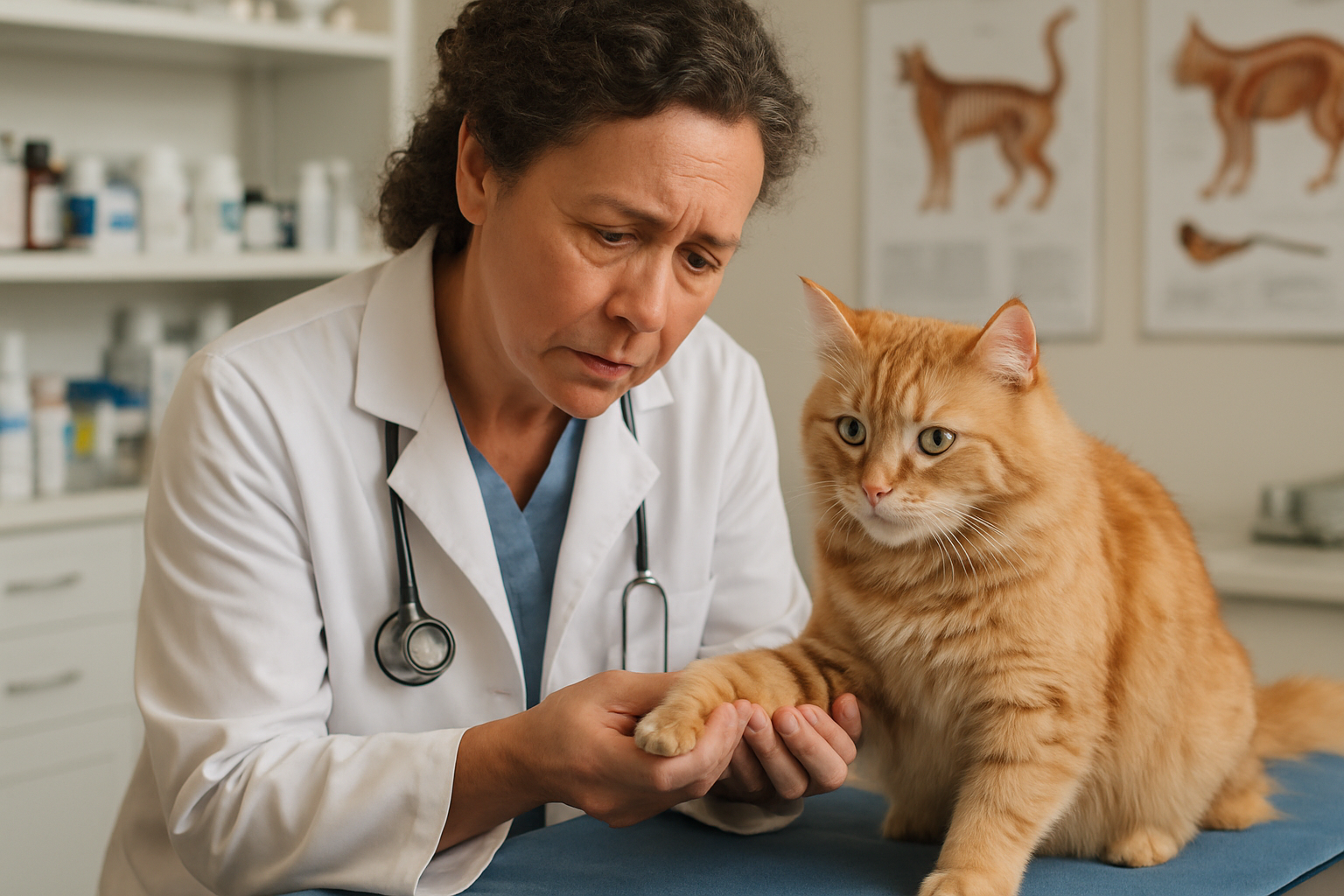Cats, known for their nimbleness and elegance, can sometimes find themselves in precarious situations leading to injuries. Whether they slip off a high ledge or get into a tussle with a neighborhood critter, a broken leg is a genuine concern for any cat owner. This situation isn’t just painful for your furry companion but calls for immediate and informed action. Knowing how to identify a broken leg in your cat can be lifesaving and save your pet from unnecessary suffering. Recognizing the difference between a sprain and a fracture is essential for timely intervention. Fortunately, numerous trusted veterinary resources, like PetMD, ASPCA, and VCA Animal Hospitals, have extensively discussed these injuries, offering valuable insights into symptoms, treatment, and care. As cats continue to adapt to indoor/outdoor lifestyles, the vigilance of pet parents in spotting signs of leg injuries becomes all the more critical.
Every cat owner hopes never to face such emergencies, but understanding this topic deeply can empower you to act swiftly if needed. From spotting subtle signs like limping and swelling to knowing how to safely transport your pet to an emergency vet, this comprehensive guide dives into everything you need to know about determining if your cat has a broken leg and ensuring they get the best possible care. The Cat Site and International Cat Care also emphasize the importance of recognizing behavioral changes, while Banfield Pet Hospital and Catster share expert advice on managing these cases.
Recognizing Clear Signs Your Cat May Have a Broken Leg – Key Symptoms To Watch Out For
Detecting a possible broken leg in your cat involves carefully observing their behavior and physical condition. Since cats are masters at hiding pain, keen attention is required to notice discomfort that might otherwise fly under the radar. Here are the primary signs to keep an eye on:
- 🐾 Limping or refusal to bear weight – If your cat is consistently avoiding putting pressure on one leg or seems to favor a limb, it’s a red flag.
- 🐾 Swelling and bruising – You might notice the leg looks puffier than usual or develops discoloration near the injury site.
- 🐾 Visible deformities – Sometimes the injured leg may appear crooked or bent unnaturally, possibly with bone protrusion in severe cases.
- 🐾 Pain responses – Yowling, hissing, or biting when the leg is touched indicates serious discomfort.
- 🐾 Behavioral shifts – Increased hiding, reduced grooming, or loss of appetite might be subtle clues that something’s wrong physically.
Many cats with a fractured leg display reluctance to move or jump. This contrasts with a simple sprain, where movement might be limited but not completely avoided. The table below sheds light on differentiating symptoms seen in broken legs versus sprains:
| Symptom | Broken Leg 🦴 | Sprain 🤕 |
|---|---|---|
| Swelling | ✔️ Usually significant | ✔️ Mild to moderate |
| Visible Deformity | ✔️ Common | ✖️ Rare |
| Weight Bearing | ✖️ Usually no | ✔️ Sometimes yes |
| Pain Reaction | ✔️ Intense | ✔️ Mild to moderate |
| Limp Severity | ✔️ Severe | ✔️ Moderate |
Recognizing these signs early can make a huge difference. The organizations like Feline Wellness and PawCare encourage cat parents not to delay seeking veterinary help as any broken bone, regardless of its location, is incredibly painful and requires professional treatment.
Understanding the Difference Between a Broken Leg and a Sprain in Cats
While both sprains and fractures cause limping and discomfort, they arise from different injuries and demand varying care approaches. Sprains involve stretched or torn ligaments around the joints, while fractures mean the bone itself has cracked or broken. ASPCA and PetMD recommend identifying these two quickly to avoid worsening the injury.
A sprain typically results from twisting injuries or awkward landings, creating tension on ligaments. The affected leg may swell, show bruising, and your cat might avoid full weight-bearing temporarily but may gradually improve with rest. On the other hand, a broken leg is a more acute injury resulting from trauma like falls, car accidents, or aggressive fights, often manifesting more drastic symptoms such as severe swelling, obvious deformities, or even open wounds.
- ✨ Sprain indicators:
- Less severe limping
- Mild to moderate swelling
- Possible bruising
- Partial weight-bearing
- Some discomfort on touch
- Less severe limping
- Mild to moderate swelling
- Possible bruising
- Partial weight-bearing
- Some discomfort on touch
- ✨ Broken leg indicators:
- Severe limping or non-weight-bearing
- Pronounced swelling and bruising
- Deformed limb appearance
- Possible bone sticking out
- Extreme pain responses
- Severe limping or non-weight-bearing
- Pronounced swelling and bruising
- Deformed limb appearance
- Possible bone sticking out
- Extreme pain responses
Understanding this distinction helps you provide immediate first aid and convey precise information to veterinarians. According to VCA Animal Hospitals, knowing whether you’re dealing with a sprain or fracture can guide you in how to safely handle and transport your cat to avoid further injury.
Steps You Should Take Immediately if You Suspect Your Cat Has a Broken Leg
When you realize your cat may have a broken leg, decisive action is critical. The calming presence and careful handling can prevent shock and further harm. Here’s a practical list of what to do right away:
- 🛑 Keep your cat still and calm – Movement can worsen the injury or cause more pain.
- 🛑 Wrap them gently in a towel or blanket to limit movement and provide warmth.
- 🛑 Contact your veterinarian or emergency vet clinic immediately to prepare them for urgent care.
- 🛑 Follow any instructions given by vet professionals over the phone carefully.
- 🛑 Transport your cat carefully using a carrier with cushioned support to the vet hospital.
- 🛑 Avoid trying to splint or manipulate the injured leg on your own, which could cause further damage.
PetMD and Banfield Pet Hospital strongly recommend telling your vet about any behavioral changes you noticed—your cat’s precise symptoms help vet staff diagnose and treat more effectively. Also, have your cat’s medical history handy, particularly if pain relievers or special care have been required in the past.
| Action | Reason to Follow 🔍 |
|---|---|
| Keep cat still | Prevents further injury and reduces pain |
| Wrap gently | Limits movement and provides comfort |
| Call vet immediately | Ensures timely professional care |
| Follow vet instructions | Maximizes chances of proper treatment |
| Transport safely | Protects your cat during the trip to the clinic |
| Avoid DIY splinting | Prevents aggravating the injury |
Veterinary Diagnosis and Treatment Options for Broken Legs in Cats
Once your feline is in the hands of professionals, the vet will take a detailed history and perform a thorough physical examination. According to International Cat Care and PawCare, diagnostic imaging, primarily X-rays, is essential for assessing the fracture’s nature, location, and severity.
The treatment plan depends on several factors—fracture type, bone involved, cat’s age, and overall health. Sometimes nonsurgical options like cage rest, casts, or splints are sufficient. But more complex fractures often require surgical intervention, including pinning or plates.
- ⚕️ Non-surgical treatments:
- Immobilization via casts or splints
- Strict rest inside a confined space
- Pain management with prescribed medication
- Immobilization via casts or splints
- Strict rest inside a confined space
- Pain management with prescribed medication
- ⚕️ Surgical treatments:
- Bone realignment and stabilization with pins, plates, or screws
- Use of external fixators in severe cases
- Post-operative care including antibiotics and pain control
- Bone realignment and stabilization with pins, plates, or screws
- Use of external fixators in severe cases
- Post-operative care including antibiotics and pain control
Recovery times vary but often require weeks to months, with attentive care and follow-up visits to monitor healing progress. Organizations like The Cat Site emphasize the importance of adhering strictly to vet-recommended activity restriction and medication protocols.
How to Care for Your Cat’s Broken Leg at Home for a Fast Recovery
Bringing your cat home after treatment sets the stage for recovery. Feline wellness practices suggest creating an environment that supports immobilization and limits stress. Here are some vital tips for home care:
- 🏡 Provide a confined, quiet space – Ideally a small room or a large crate with soft bedding to reduce jumping or excessive movement.
- 🏡 Place food, water, and litter box close by so your cat doesn’t have to move far.
- 🏡 Administer prescribed medications strictly and monitor your cat for side effects.
- 🏡 Regularly check the bandage or splint for signs of tightness, moisture, or discharge.
- 🏡 Limit handling and discourage jumping to avoid setbacks in healing.
- 🏡 Schedule follow-up vet appointments for reevaluation and potential bandage changes or pain management updates.
Keeping your cat calm can sometimes mean adjusting your own routine to provide more comfort and companionship. Catster and PawCare stress that emotional support is as crucial as physical care to speed healing and maintain your pet’s wellbeing.
| Home Care Step | Why it’s Important 🌟 |
|---|---|
| Confined quiet space | Prevents excessive movement and protects the healing leg |
| Accessible essentials | Reduces stress and physical strain during recovery |
| Medication adherence | Manages pain and prevents infection |
| Bandage monitoring | Ensures proper circulation and hygiene |
| Limiting activity | Supports proper bone healing |
Knowing what to expect and preparing for potential challenges can make the recovery period smoother for both you and your kitty. Many owners liken the experience to handling a toddler—requiring patience, attention, and lots of love.
FAQ about Cat Broken Legs and Injuries 🐱💡
- ❓ How can I tell if my cat’s leg is broken or just sprained?
Look for severe limping, swelling, deformity, or refusal to bear weight for fractures. Sprains usually cause mild swelling and allow some movement. X-rays are the best way to differentiate.
- ❓ Is it safe to make a splint on my own for a cat’s broken leg?
No. DIY splinting can worsen the injury. Always seek professional veterinary help to immobilize the leg correctly.
- ❓ How long does it take for a cat’s broken leg to heal?
Healing can take anywhere from 6 to 12 weeks depending on injury severity and treatment quality. Follow vet instructions closely for best results.
- ❓ Can indoor cats suffer leg fractures?
While less common, indoor cats can still break legs from falls, accidents, or fights just like outdoor cats. Vigilance is necessary regardless of lifestyle.
- ❓ What are the costs related to treating a broken leg in cats?
Costs vary widely based on injury severity and treatment needed, ranging from a few hundred to thousands of dollars. Pet insurance can help offset expenses.

